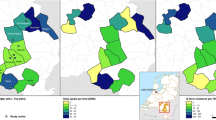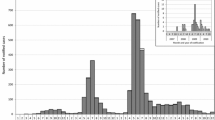Abstract
To determine the incidence of Q fever in Nova Scotia, a randomly selected sample of 492 volunteers aged 18–70 years was recruited by mail from all 18 urban and rural counties in this province. Volunteers were followed from 1988 to 1991 for antibody titres toCoxiella burnetii antigens. Analysis of seroprevalence by age revealed two statistically different cohorts. Those younger than 35 years had a low, stable seroprevalence while those 35 years and older had a seroprevalence statistically correlated with increasing age. The finding of age related cohorts suggests a sporadic or cyclical infection rate. An age-independent geographical clustering was also noted, with higher seroprevalence in a major agricultural area of the province. No seroconversions were observed, but four subjects had seroreversions. At baseline, 72 (14.6%) of the 492 subjects were considered seropositive (>/1:8C. burnetii phase II antibody titre by microimmunofluorescence). Of 47 seropositive subjects who provided yearly serum samples, two (4.3%) showed >/4-fold increase in antibody titre and did not react to antigens of the 11 other respiratory pathogens tested, suggesting a reactivation of Q fever. All 22 subjects positive to phase I antigen were positive to phase II antigen. This study suggests that the rate of infection in Nova Scotia has been low since the 1960's and that risk of infection is associated more with a geographically clustered reservoir of infection than with occupation or gender.
Similar content being viewed by others
References
Anonymous. Q-fever in 1988–1989. WHO Weekly Epidemiol Record 1991; 33: 147.
Babudieri B. Q fever: A zoonosis. Adv Vet Sci 1959; 5: 81–182.
Cremer NE, Devlin VL, Riggs JL, Hagens SJ. Anomalous antibody responses in viral infection: Specific stimulation or polyclonal activation? J Clin Microbiol 1984; 20: 468–472.
Dupont HT, Thiron X, Raoult D. Q fever serology: Cutoff determination for microimmunofluorescence. Clin Diagn Lab Immunol 1994; 1: 189–196.
Dupuis G, Petite J, Peter O, Vouilloz M. An important outbreak of human Q fever in a Swiss Alpine valley. Int J Epidemiol 1987; 16: 282–287.
Embil J, Williams JC, Marrie TJ. The immune response in a cat-related outbreak of Q fever as measured by the indirect immunofluorescence test and the enzyme-linked immunosorbent assay. Can J Microbiol 1990; 36: 292–296.
Enright JB, Franti CE, Longhurst WM, Behymer DE, Wright ME, Dutson VJ.Coxiella burned in a wildlife-livestock environment: Antibody response of ewes and lambs in an endemic Q fever area. Am J Epidemiol 1971; 94: 62–71.
Kosatsky T. Household outbreak of Q-fever pneumonia related to a parturient cat. Lancet 1984 (ii): 1447–1449.
Koster FT, Williams JC, Goodwin JS. Cellular immunity in Q fever: Specific lymphocyte unresponsiveness in Q fever endocarditis. J Infect Dis 1985; 152: 1283–1289.
Langley JM, Marrie TJ, Covert A, Waag DM, Williams JC. Poker players' pneumonia: An urban outbreak of Q fever following exposure to a parturient cat. N Engl J Med 1988; 319: 354–356.
Lev BI, Shachar A, Segev S, Weiss P, Rubinstein E. Quiescent Q fever endocarditis exacerbated by cardiac surgery and corticosteroid therapy. Arch Intern Med 1988; 148: 1531–1532.
Macellaro A, Akesson A, Norlander L. A survey of Q-fever in Sweden. Eur J Epidemiol 1993; 9: 213–216.
Marrie TJ. Epidemiology of Q fever. In: Marrie TJ, ed. Q Fever — The Disease. Boca Raton, FL: CRC Press, Inc., 1990; 1: 49–70.
Marrie TJ, Durant H, Williams JC, Mintz E, Waag DM. Exposure to parturient cats: A risk factor for acquisition of Q fever in Maritime Canada. J Infect Dis 1988; 158: 101–108.
Marrie TJ, Durant H, Yates L. Community-acquired pneumonia requiring hospitalization: 5-year prospective study. Rev Infect Dis 1989; 11: 586–599.
Marrie TJ, Haldane EV, Noble MA, Faulkner RS, Martin RS, Lee SH. Causes of atypical pneumonia: results of a 1-year prospective study. Can Med Assoc J 1981; 125: 1118–1123.
Marrie TJ, Van Buren J, Faulkner RS, Haldane EV, Williams JC, Kwan C. Seroepidemiology of Q fever in Nova Scotia and Prince Edward Island. Can J Microbiol 1984; 30: 129–134.
McDade JE, Shepard CC, Fraser DW, Tsai TR, Redus MA, Dowdle WR. Legionnaires' disease: Isolation of a bacterium and demonstration of its role in other respiratory disease. N Engl J Med 1977; 297: 1197–1203.
Meurman O, Lehtonen OP. Fluctuation of virus antibody levels in healthy adults. Eur J Clin Microbiol Infect Dis 1988; 7: 656–658.
Philip RN, Casper EA, Ormsbee RA, Peacock MG, Burgdorfer W. Microimmunofluorescence test for the serological study of rocky mountain spotted fever and typhus. J Clin Microbiol 1976; 3: 51–61.
Ross PJ, Jacobson J, Muir JR. Q fever endocarditis of porcine xenograft valves. Am Heart J 1983; 105: 151–153.
Sidwell RW, Thorpe BD, Gebhardt LP. Studies of latent Q fever infections, I: Effects of whole body x-irradiation upon latently infected guinea pigs, white mice and deer mice. Am J Hyg 1964; 79: 113–124.
Sidwell RW, Thorpe BD, Gebhardt LP. Studies of latent Q fever infections, II: Effects of multiple cortisone injections. Am J Hyg 1964; 79: 320–327.
Smith DL, Ayres JG, Blair I, Burge PS, Carpenter MJ, Caul EO, Coupland B, Desselberger U, Evans M, Farrell ID, Hawker JI, Smith EG, Wood MJ. A large Q fever outbreak in the West Midlands: Clinical aspects. Respir Med 1993; 87: 509–516.
Stoker MGP, Marmion BP. The spread of Q fever from animals to man: The natural history of a rickettsial disease. Bull World Health Organ 1955; 13: 781–806.
Wood RJ. Alternative ways of estimating serological titer reproducibility. J Clin Microbiol 1981; 13: 760–768.
Author information
Authors and Affiliations
Rights and permissions
About this article
Cite this article
Marrie, T.J., Pollak, P.T. Seroepidemiology of Q fever in Nova Scotia: Evidence for age dependent cohorts and geographical distribution. Eur J Epidemiol 11, 47–54 (1995). https://doi.org/10.1007/BF01719945
Accepted:
Issue Date:
DOI: https://doi.org/10.1007/BF01719945




